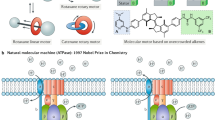Abstract
The recognition of many enzymes as nanoscale molecular motors has opened the door for the potential creation of hybrid organic/inorganic nano-electro-mechanical (NEMS) devices. The long-term objective of this research is the integration of F 1-ATPase with NEMS to produce useful nanoscale devices. A thermostable F 1-ATPase coding sequence has been isolated, cloned, and engineered for high-level protein expression. Precise positioning, orientation, and spacing of individual F 1-ATPase molecules were achieved on patterned nickel arrays produced using electron beam lithography. An efficient and accurate assay was developed to evaluate the performance of individual F 1-ATPase motors, and confirmed a three-step mechanism of γ subunit rotation during ATP hydrolysis. Further assessment of the biophysical and bioengineering properties of FF 1-ATPase currently are being conducted, as well as the construction of a hybrid NEMS device powered by FF 1-ATPase. The evolution of this technology will permit the creation of novel classes of nanoscale, hybrid devices.
Similar content being viewed by others
References
S. Abramowitz, Journal of Biomedical Microdevices 1, 107 (1999).
M.A. Bianchet, J. Hullihen, P.L. Pedersen, and L.M. Amzel, Proceedings of the National Academy of Science USA 95, 11065 (1998).
D.W. Carr and H.G. Craighead, Journal of Vacuum Science and Technology B 15, 2760 (1997).
H.G. Craighead and P.M. Mankiewich, Journal of Applied Physics 53, 7186 (1982).
K. Kinosita Jr, R. Yashida, H. Noji, S. Ishiwata, and M. Yoshida, Cell 93, 21 (1998).
K. Kitamura, M. Tokunaga, A.H. Iwane, and T. Yanagida, Nature 397, 129 (1999).
M.J. Lercel, H.G. Craighead, A.N. Parikh, K. Seshadri, and D.L. Allara, Applied Physics Letters 68, 1504 (1996).
M.J. Lercel, G.F. Redinbo, M. Rooks, R.C. Tiberio, H.G. Craighead, C.W. Sheen, and D.L. Allara, Microelectronic Engineering 13, 43 (1995).
A.D. Mehta, M. Rief, J.A. Spudich, D.A. Smith, and R.M. Simmons, Science 283, 1689 (1999).
C.D. Montemagno and G.D. Bachand, Nanotechnology 10, 225 (1999).
H. Noji, R. Yashuda, M. Yoshida, and K. Kinosita Jr, Nature 386, 299 (1997).
A. Oplatka, Biochemical and Biophysical Communications 246, 301 (1998).
R.K. Soong, S.J. Stelick, G.D. Bachand, and C.D. Montemagno, Evaluating Adhesion Strength of Biological Molecules to Nanofabricated Substrates, in Technical Proceedings of the Second Conference on Modeling and Simulation of Microsystems (Computational Publications, Cambridge, 1999), 95-98.
M.D. Wang, M.J. Schnitzer, H. Yin, R. Landick, J. Gelles, and S.M. Block, Science 282, 902 (1998).
R. Yashuda, H. Noji, K. Kinosita Jr, and M. Yoshida, Cell 93, 1117 (1998).
Author information
Authors and Affiliations
Rights and permissions
About this article
Cite this article
Bachand, G.D., Montemagno, C.D. Constructing Organic/Inorganic NEMS Devices Powered by Biomolecular Motors. Biomedical Microdevices 2, 179–184 (2000). https://doi.org/10.1023/A:1009924327649
Issue Date:
DOI: https://doi.org/10.1023/A:1009924327649




